The Best 4-Week Indian Diet Plan For Weight Loss
A comprehensive food and nutrition guide customized for South Asian people.

Image: StyleCraze
About 135 million Indians are experiencing obesity due to their unhealthy food habits (1). This puts women, men, and even children equally at the risk of heart disease, diabetes, and cancer (2).
A study predicted that the overweight prevalence may double among Indian adults aged 20–69 years by the year 2040, while the rate of obesity may triple. The prevalence of overweight among women will increase from 14.7% to 27.4% by 2040, and the prevalence of obesity is estimated to increase from 4.4% to 14.0% by 2040.
Fortunately, following an Indian diet for weight loss is quite effective.
Which Indian diet are we talking about? It is a four-week lactovegetarian diet plan, specially designed using Ayurvedic ingredients that induce weight loss and improve health (3).
Plant-based diets, including vegan and vegetarian diets, are highly effective in bringing down the risk of obesity and related diseases (4). A balanced diet is all about eating the right amount of carbs, protein, and fat. This is the key to losing weight safely. By choosing whole foods that are packed with nutrients, you can reach your weight loss goals without sacrificing your health.
The best part about it is that Indian cuisine is replete with vibrant spices, fresh herbs, and rich flavors.
In this article, we dig deeper into this doctor-approved four-week diet plan, how it works, and more. Keep reading!
In This Article
What Is The Indian Diet Plan?

A weight loss diet that is based on whole, nutrient-dense foods is sustainable and is generally recommended for long-term success. The Indian diet plan is a 4-week vegetarian/lactovegetarian diet for people struggling to lose weight on other diets. Following a diet chart for weight loss can be a helpful tool in achieving your fitness goals, as it provides a structured plan for healthy eating.
Alisa, a blogger, reflects on her 10-month journey of making positive changes to her eating habits, sharing insights on cutting back on sugar and carbs, eliminating processed food, staying hydrated, and incorporating fresh fruits and vegetables, emphasizing, “This food journey for me was never about losing weight, it was about getting my body feeling better, and I am happy to say that after 10 months of making good choices with food, my body is feeling so much better (i)!”
The rise of obesity and obesity-related diseases across ages in India prompted the creation of this diet. However, a balanced plant-based diet is good for human health and wellness irrespective of ethnicity and geographical location.
It is important to note that a weight loss diet chart is typically tailored to an individual’s specific needs and goals. Following a diet chart for weight loss for females can be an effective way to lose weight and improve overall health, but it is important to consult a healthcare professional before starting any new diet.
Remember, a perfect diet chart for weight loss in one month is one that advocates sustainable weight loss, with a focus on balanced meals and exercise.
How Does It Work?
Generally, a weight loss diet chart for females should include a balance of whole grains, lean proteins, fruits, vegetables, and healthy fats, tailored to individual needs and preferences. Similarly, an Indian diet chart for weight loss for females may include traditional foods such as dal, roti, vegetables, and yogurt, with an emphasis on portion control and moderation. The Indian diet plan works in the following ways:
- It is a lacto-vegetarian diet. This means you will consume lots of dietary fiber from vegetables and leafy greens. You will also consume milk protein and calcium. Whether you are following this diet or a complete veg diet plan for weight loss, both require the inclusion of healthy protein sources.
Dietary fiber helps improve satiety and bowel movement (5). Milk and milk products increase the number of good gut bacteria, increase satiety, and strengthen the bones (6).
- It is low calorie. The Indian diet is a low-calorie diet, just like any other 1500-calorie diet, which focuses on restricted calorie intake while maintaining proper nutritional supply. The foods included in the list are delicious but do not burden the body with too many calories. The lesser calories you consume, the better the chances of you losing weight.
- It focuses on having multiple meals throughout the day. Eating smaller meals more often can help your metabolism work better and make you feel fuller for longer. This can help you manage your hunger throughout the day and stick to your weight loss goals.
- It has the power to heal. Ayurveda is the “medicine of life”. This age-old science encourages the consumption of foods that help create a balance between the mind, heart, and spirit.
Being on this diet can help you stay stress-free and calm, both of which are necessary for weight loss.
- It is digestion and diabetes-friendly. The foods included in this diet plan keep your digestion active, which, in turn, boosts metabolism. It also includes foods with a low glycemic index, a boon for people with type 2 diabetes.
Overall, a diet for weight loss should focus on reducing calorie intake. A high-fiber lacto-vegetarian Indian diet plan is a great option for slimming down. But you must know which foods you need to consume and in what quantities.
A beginner diet plan for weight loss for females should be simple and sustainable. Portion control is one of the key factors of weight loss. One of the ways you can measure your food intake to develop a fat-loss diet chart is by knowing how many calories should you consume per day. Here’s a table that will help you estimate your daily calorie intake and determine a weight-loss food chart.
Recommended Caloric Intake For Indians (7)
(As per the National Institute of Nutrition, India)
| Group | Activity | Weight (kg) | Calories Recommended | Protein | Fat |
|---|---|---|---|---|---|
| Woman | Sedentary | 55 | 1900 | 55 | 20 |
| Moderately active | 2230 | 25 | |||
| Very Active | 2850 | 30 | |||
| Pregnant | +350 | +23 | 30 | ||
| Lactating (0-6 months) | +600 | +19 | 30 | ||
| Lactating (6-12 months) | +520 | +13 | 30 | ||
| Man | Sedentary | 60 | 2320 | 60 | 25 |
| Moderately active | 2730 | 30 | |||
| Very Active | 3490 | 40 |
Simply put, your calorie intake depends on the level of activity you do every day.
If you are sedentary, 1900 calories will just help to maintain the current weight. To lose weight, you may either start exercising or subtract 500 calories from 1900 calories (8). The goal is to create a negative calorie balance in your meal plan.
In this post, we have a 4-week 1500-calorie diet plan. Remember, if you include exercises in your routine, you may consume 1900 calories (or more depending on the level and intensity of the exercises you do).
4-Week Indian Diet Plan For Weight Loss
Week 1 – Total Calories: 1509
| MEALS | WHAT TO EAT |
|---|---|
| Early Morning (6:30 – 7:30 a.m.) | 2 teaspoons of fenugreek seeds soaked overnight in 1 cup of water |
| Breakfast (7:30 – 8:30 p.m.) | 2 idlis with 1 cup sambar and ¼ cup coconut chutney + 1 cup green tea + 4 almonds |
| Mid-Morning (10:00 – 10:30 a.m.) | 1 fruit of your choice |
| Lunch (12:30 – 1:00 p.m.) | 2 rotis + 1 serving white rice + 1 cup dal + 1 cup mixed vegetable curry + 1 cup salad + 1 cup buttermilk (after 20 minutes) |
| Post Lunch (3:30 – 4:00 p.m.) | 1 cup moong bean sprouts, 15 peanuts with salt pepper and lemon to taste Or 1 cup cucumber and carrot slices |
| Dinner (7:00 – 7:30 p.m.) | 2 rotis + ½ cup mixed vegetable curry / chickpeas + 1 cup low-fat curd + 1 cup salad + 1 cup warm skim milk with a pinch of turmeric before bed |
How You Will Feel By The End Of Week 1
Following a healthy diet chart for weight loss gives you healthy choices to achieve your fitness goals. You will lose water weight, and a healthy eating habit will prevent bloating. You will weigh less and feel light and happy. But don’t give up yet! The main goal is fat loss, so move on to week 2.
Week 2 – Total Calories: 1497
| MEALS | WHAT TO EAT |
|---|---|
| Early Morning (6:30 – 7:30 a.m.) | 1 cup fenugreek soaked water/ 1 cup chia seeds soaked in water |
| Breakfast (7:30 – 8:30 p.m.) | 2 moong daal crêpes + 1 cup green tea + 4 almonds |
| Mid-Morning (10:00 – 10:30 a.m.) | 1 cup seasonal fruits |
| Lunch (12:30 – 1:00 p.m.) | 2 rotis or 1 serving of rice + 1 cup vegetable curry + ½ cup lentil curry + 1 cup salad + 1 cup low-fat curd |
| Post Lunch (3:30 – 4:00 p.m.) | 1 cup coconut water + ½ cup grapes/watermelon |
| Dinner (7:00 – 7:30 p.m.) | 2 rotis + ½ cup mushroom/tofu curry + ½ cup blanched spinach/broccoli + 1 cup warm milk with a pinch of turmeric before bed |
How You Will Feel By The End Of Week 2
You will start to burn fat with this best diet chart for weight loss. You will feel better as your digestion, gastritis, and weak immunity problems will slowly start to vanish. You will love your new lifestyle and look forward to Week 3.
Week 3 – Total Calories:1536
| MEALS | WHAT TO EAT |
|---|---|
| Early Morning (6:30 – 7:30 a.m.) | 1 cup water with juice of half a lime/ 10 ml amla juice |
| Breakfast (7:30 – 8:30 p.m.) | 1 cup vegetable oats + 1 cup green tea + 4 almonds/walnut |
| Mid-Morning (10:00 – 10:30 a.m.) | 1 cup freshly pressed fruit juice |
| Lunch (12:30 – 1:00 p.m.) | ½ cup white rice + 1 roti (with or without ghee) + 1 cup rajma + 1 cup salad + 1 cup buttermilk |
| Post Lunch (3:30 – 4:00 p.m.) | 1 fruit of your choice |
| Dinner (7:00 – 7:30 p.m.) | 2 rotis + ½ cup daal + 1 cup vegetable stew + ½ cup salad + 1 piece of dark chocolate + 1 cup warm milk before bed |
How You Will Feel By The End Of Week 3
You will weigh at least 5 pounds lesser and be more proactive. Your attention span will increase. Having a cheat day will also improve your mood and determination to complete Week 4 of the Indian diet plan for weight loss.
Week 4 – Total Calories:1486
| MEALS | WHAT TO EAT |
|---|---|
| Early Morning (6:30 – 7:30 a.m.) | 1 cup water with juice of half a lime/ 10 ml wheatgrass juice |
| Breakfast (7:30 – 8:30 p.m.) | ½ cup vegetable upma + 1 cup milk / green tea + 2 almonds |
| Mid Morning (10:00 – 10:30 a.m.) | 1 cup seasonal fruits |
| Lunch (12:30 – 1:00 p.m.) | 2 rotis + 1 cup vegetable curry + 1 cup lentil/beans + ½ cup salad + ½ cup low-fat curd |
| Post Lunch (3:30 – 4:00 p.m.) | 1 cup coconut water or freshly pressed fruit juice or green tea |
| Dinner (7:00 – 7:30 p.m.) | 1 roti or 1 serving of brown rice + 1 cup daal/mushroom + ½ cup boiled vegetables + 1 cup warm milk before bed |
How You Will Feel By The End Of Week 4
Good job! You adhered to the diet plan to reduce weight and can clearly see the results for yourself. You look much slimmer, you are more active, and you are proud of yourself. You can also make your own diet chart depending on the foods you like and have access to. Here’s an Indian food calorie table to help you do that.
You can also make your own diet chart depending on the foods you like and have access to. Here’s an Indian food calorie table to help you do that.
Common Indian Food Calorie Table
(As per the National Institute of Nutrition)
| Food | Serving Size | Calories |
|---|---|---|
| Rice | 1 cup | 170 |
| Paratha | 1 | 150 |
| Roti | 1 | 80 |
| Bread | 2 slices | 170 |
| Puri | 1 | 80 |
| Upma | 1 cup | 270 |
| Idlis | 2 | 150 |
| Poha | 1 cup | 270 |
| Dosa | 1 | 125 |
| Masala dosa | 1 | 200 |
| Wheat porridge | 1 cup | 220 |
| Semolina porridge | 1 cup | 220 |
| Khichdi | 1 cup | 200 |
| Plain daal | ½ cup | 100 |
| Sambhar | 1 cup | 110 |
| Vegetable curry | 1 cup | 170 |
| Vegetable dry | 1 cup | 150 |
| Tomato chutney | 1 tablespoon | 10 |
| Tamarind chutney | 1 tablespoon | 60 |
| Rice puttu | ½ cup | 180 |
| Moong daal chilla | 1 | 98 |
| Chikki | 2 pieces | 290 |
| Full-fat cow’s milk | 1 cup | 148 |
| Buffalo milk | 1 cup | 237 |
| Homemade yogurt | ½ cup | 103 |
| Buttermilk | 1 cup | 99 |
| Dahi vada | 2 | 180 |
| Peas kachori | 2 | 380 |
Apart from these foods, here’s list of foods that you may include in your diet.
Foods To Eat
| Veggies | Broccoli, tomato, cabbage, cauliflower, snake gourd, bitter gourd, spinach, bell pepper, bottle gourd, green chili, pumpkin, okra, eggplant, radish, turnip, carrot, beetroot, sweet potato, potato with peel, radish greens, peas, summer squash, and green beans. |
| Fruits | Apple, banana, mango, grapes, sapodilla, lime, lemon, orange, pear, figs, blueberry, starfruit, watermelon, and muskmelon. |
| Protein | Beans, lentils, soybeans, tofu, and legumes. |
| Grains & Bread | Oats, wheat, buckwheat, barley, sorghum, amaranth, and quinoa. |
| Fats & Oils | Olive oil, rice bran oil, and ghee (clarified butter). |
| Seeds & Nuts | Almonds, pistachios, walnuts, pumpkin seeds, flax seeds, sesame seeds, and sunflower seeds.
|
| Beverages | Freshly pressed fruit and vegetable juices, coconut water, buttermilk, green tea, herbal tea, and black coffee. |
| Herbs & Spices | Cinnamon, cardamom, turmeric, nutmeg, black pepper, star anise, cayenne pepper, cumin powder, coriander powder, cilantro, oregano, dill, clove, saffron, fennel seeds, and fenugreek seeds.
|
| Dairy | Yogurt, paneer, and ricotta cheese. |
Also, try to avoid the foods listed below.
Foods To Avoid
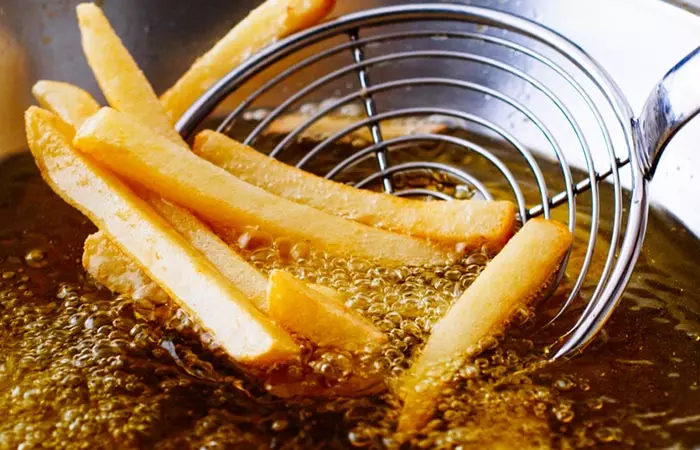
- Butter, mayonnaise, canola oil, and vegetable oil.
- Deep-fried foods, potato chips, doughnut, nachos, fries, pizza, burger, etc.
- Aerated drinks, artificially sweetened drinks, packaged fruit juices, and alcohol.
- Ready-to-eat food and frozen foods.
 Quick Tip
Quick TipThe National Institute of Nutrition recommends physical exercise to live a healthy life. Here’s a simple 20-minute workout routine that you can do in the comfort of your home.
Exercise Plan
- Head tilt – 1 set of 10 reps
- Neck rotations – 1 set of 10 reps
- Shoulder rotations – 1 set of 10 reps
- Arm circles – 1 set of 10 reps
- Wrist rotations – 1 set of 10 reps
- Waist rotations – 1 set of 10 reps
- Ankle rotation – 1 set of 10 reps
- Spot jogging – 5 minutes
- Jumping jacks – 2 sets of 20 reps
- Side lunges – 1 set of 15 reps
- Forward bend – 1 set of 10 reps
- Standing side crunches – 2 sets of 10 reps
- Russian twist – 2 sets of 20 reps
- Crunches – 3 sets of 10 reps
- Full squat – 2 sets of 10 reps
- Explosive forward lunges – 2 sets of 10 reps
- Burpees – 1 set of 10 reps
- Sit-ups – 1 set of 10 reps
- Bicep curls (5 lb weights) – 2 sets of 10 reps
- Tricep dips – 2 sets of 5 reps
- Push-ups – 2 sets of 10 reps
- Lying leg circles – 1 set of 10 reps
- Horizontal kicks – 1 set of 10 reps
- Forward elbow plank – 20-second hold
- Stretch
You can also do swimming, running, walking, dancing, cycling, or yoga. Here are a few weight loss tips to help you.
Weight Loss Tips

- Try to consume at least five different types of veggies and three different types of fruits per day.
- Avoid consuming too much oil. Though ghee is good for health, avoid it for a few days.
- Drink the leftover water when you make ricotta cheese at home. It is packed with protein.
- Do not throw away the soft spinach stem or the crunchy broccoli stalk, considering them inedible. Wash them and slice off half an inch of the broccoli stalk or the soft spinach leaf stem. You can use the rest as these parts of the veggies are highly nutritious.
- Mix cardio and strength training. Make sure you lose the fat first through cardio and then slowly integrate strength training into your exercise routine.
- Sleep for at least 7-8 hours a day.
- Meditate and de-stress.
- Stay hydrated.
Here are some additional tips to help you plan and follow your Indian diet for weight loss:
Meal Planning Tips
Weight loss takes time and effort. So, be patient and consistent to reach your goals. Here are some tips to make your journey easier:
- Involve your family and include them in your diet plan to make it easier to stick to your goals and enjoy healthy meals together.
- Try new Indian recipes to keep meals interesting and prevent boredom.
- Pay attention to hunger and fullness cues. Eat only when you feel hungry and stop when satisfied.
- Stay motivated and accountable by joining a weight loss group or finding a workout buddy.
- Prepare meals in advance to save time and reduce the temptation to order unhealthy takeout.
- Keep a food journal to monitor your food consumption patterns and stay accountable.
Despite making changes in your diet and following these tips, you may notice you are not losing weight. Find out the potential reasons behind this in the next section.
Reasons You Are Not Losing Weight
There are several factors that hinder weight loss. These include:
- Overeating: Consuming more calories than you burn can lead to weight gain, especially if you are not active.
- Unbalanced Diet: Eating too much processed and fatty food and sugar can impede progress.
- Lack Of Physical Activity: Not being active throughout the day slows down metabolism and calorie burning.
- Medical Conditions: Hormonal imbalances, thyroid issues, or certain medications may cause weight gain.
- Inconsistent Sleep: Poor sleep may disrupt your metabolism and hunger hormones.
- Stress: Elevated stress levels may lead to emotional eating and weight gain.
- Genetics: Genetic factors can influence your metabolism and fat storage.
- Aging: Your metabolism naturally slows down with age, making weight loss harder.
 Quick Tip
Quick TipInfographic: Healthy Indian Snack Options For Weight Loss
Staying away from processed and unhealthy food is crucial for weight loss. However, there are many easy-to-make healthy snacking options to manage your cravings. Check out the infographic below to learn about some healthy Indian snack options for weight loss. Illustration: StyleCraze Design Team
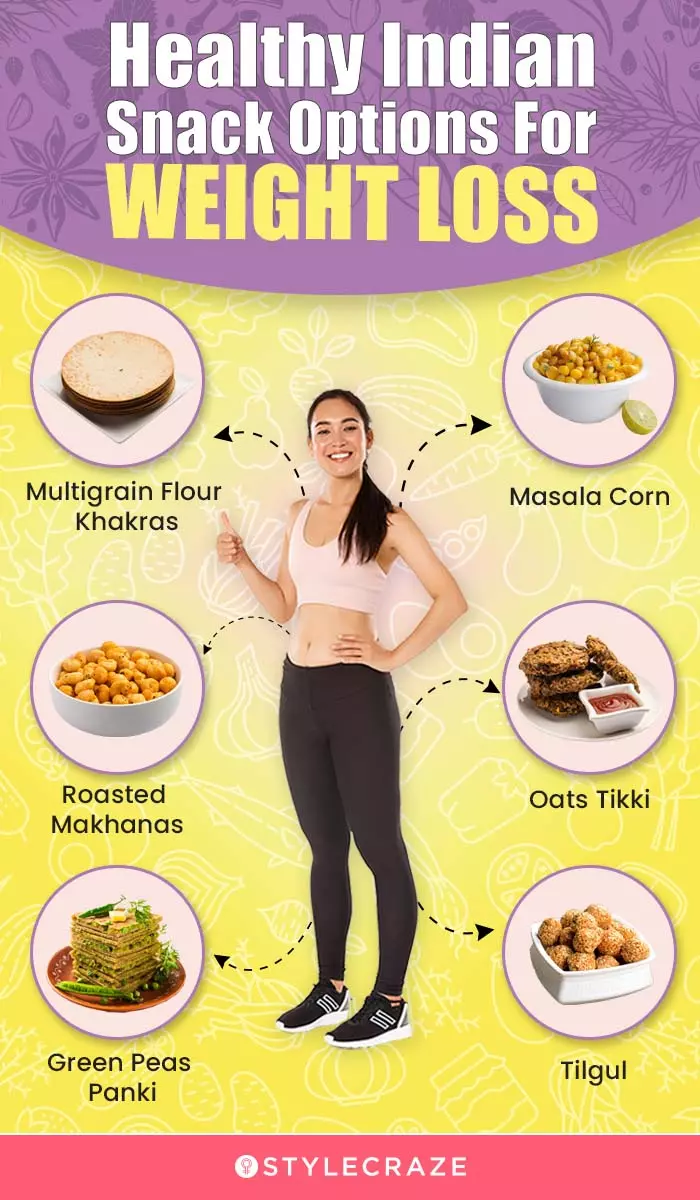
The Indian diet plan for weight loss spans over a time of 4-weeks and includes ayurvedic ingredients that help manage your weight and improve overall health and immunity. It is a lactovegetarian diet plan that includes the goodness of calcium from dairy products and dietary fiber, minerals, and essential vitamins from the leafy greens and vegetables. You can also turn it gluten-free with a few changes to it. Replete with vibrant spices and fresh herbs, this diet keeps you satiated and happy with its flavors. Staying hydrated along with an active lifestyle while following this diet would help you get the best results.
Frequently Asked Questions
Can I eat biryani while on this diet plan?
If you are ready to run 1 km, do 20 push-ups, and 30 crunches, you can eat biryani while you are on this diet! Jokes apart, yes, you will be tempted to deviate from your goal, but be firm, and it will become a habit. Once you lose weight, you can indulge in high-calorie food once a week.
How much weight will I lose by following the 1500-calorie Indian Diet Plan for weight loss?
If you adhere to the diet and exercise plan for 4 weeks, you can lose up to 5 kg.
Can I drink tea with milk and sugar?
No, unfortunately, sugar and milk tend to destroy the goodness of tea. Moreover, you consume more sugar in teas, packaged fruit juices, sodas, etc. So, avoid all kind of drinks that have sugar or artificial sweeteners.
Which oil to use for cooking?
When it comes to cooking oils, there are many to choose from. Different oils have different qualities that make them better for different uses. Some are good for baking, some are good for frying, and some are good for salad dressing. Before you pick an oil, it is important to assess the needs of the recipes you are trying to follow. If you are trying to fry something, you’ll want to opt for oil with a neutral flavor and a high smoking point (point at which oil begins to smoke and become ineffective).
Mentioned below are oils that can be used for various forms of cooking:
Vegetable Oil – Frying, roasting, and baking
Safflower Oil – Frying and sautéing
Peanut Oil – Frying and sautéing
Sesame Oil – Sautéing
Coconut Oil – Baking
Pure Olive Oil – Frying
Extra Virgin Olive Oil – Sautéing and drizzling
It is always better to keep changing the type of oil on a monthly basis so that the body gets adequate amount of fats present in different types of oil.
How much oil to use for cooking?
Two to three teaspoons of oil in a day is recommended for healthy living and keep illness and diseases at bay. One should be consuming a maximum of only ½ liter of oil per month.
Can I consume ghee?
Ghee is good for you and a great anti-inflammatory agent. Yes, you can use ghee but not more than 3 tablespoons per day if you want to lose weight.
Can I use spices to prepare curries?
Yes, you can use spices. Spices are the essence of Indian cooking. But do not use too much as spicy food can irritate the stomach lining, leading to infections and digestive and liver problems – which are a few reasons for weight gain.
What cooking method should I use?
Do not overcook your food. Overcooking or over frying can denature the nutrients in the veggies. If you wish to reheat the earlier cooked food that was stored, do not overheat it. The more you heat or boil food, the lower the nutrition value of food will be. Try eating salads raw. Blanch instead of boiling or frying. Completely avoid deep frying. You can consume steamed food.
I crave for sweets after every meal. What should I do?
You have a few options: A. Eat homemade sweets that contain a minimum amount of sugar. B. Have a piece of dark chocolate. C. Have fruits an hour post-lunch. D. Chew a clove after every meal.
Key Takeaways
- This ancient science promotes eating meals that work to bring about harmony between the mind, heart, and spirit.
- The Indian diet plan is a lactovegetarian diet plan that may influence weight loss.
- The most important aspect of weight loss is portion control.
- Regular exercise and yoga can be included in your daily routine to aid weight loss and improve fitness.
Embark on a transformative weight loss journey with our comprehensive 2-week meal plan featuring delicious vegetarian Indian cuisine. In this exciting video, discover nourishing recipes and effective strategies to achieve your fitness goals while satisfying your heart.
Personal Experience: Source
StyleCraze's articles are interwoven with authentic personal narratives that provide depth and resonance to our content. Below are the sources of the personal accounts referenced in this article.
i. my journey with healthy eatinghttps://alisaburke.blogspot.com/2015/04/my-journey-with-healthy-eating.html
References
Articles on StyleCraze are backed by verified information from peer-reviewed and academic research papers, reputed organizations, research institutions, and medical associations to ensure accuracy and relevance. Read our editorial policy to learn more.
- “Prevalence of obesity in India: A systematic review” Diabetes & Metabolic Syndrome: Clinical Research & Reviews, ScienceDirect.
- “The medical risks of obesity.” Postgraduate Medicine, National Institute of Health.
- “Traditional and ayurvedic foods of Indian origin” Journal of Ethnic Foods, ScienceDirect.
- “A plant-based diet for overweight and obesity prevention and treatment” Journal of Geriatric Cardiology : JGC, National Institute of Health.
- “Dietary Fiber” Diet and Health: Implications for Reducing Chronic Disease Risk, National Institute of Health.
- “Association between Yogurt Consumption and Intestinal Microbiota in Healthy Young Adults Differs by Host Gender” Frontiers in Microbiology, National Institute of Health.
- “Dietary Guidelines for Indians” ICMR
- “Dietary intakes associated with successful weight loss and maintenance during the Weight Loss Maintenance Trial” Journal of the American Dietetic Association, National Institute of Health.
- “Whether Smaller Plates Reduce Consumption Depends on Who’s Serving and Who’s Looking: A Meta-Analysis” Journal of the Association for Consumer Research, ResearchGate.
Read full bio of Merlin Annie Raj
Read full bio of Ravi Teja Tadimalla
Read full bio of Aparna Mallampalli








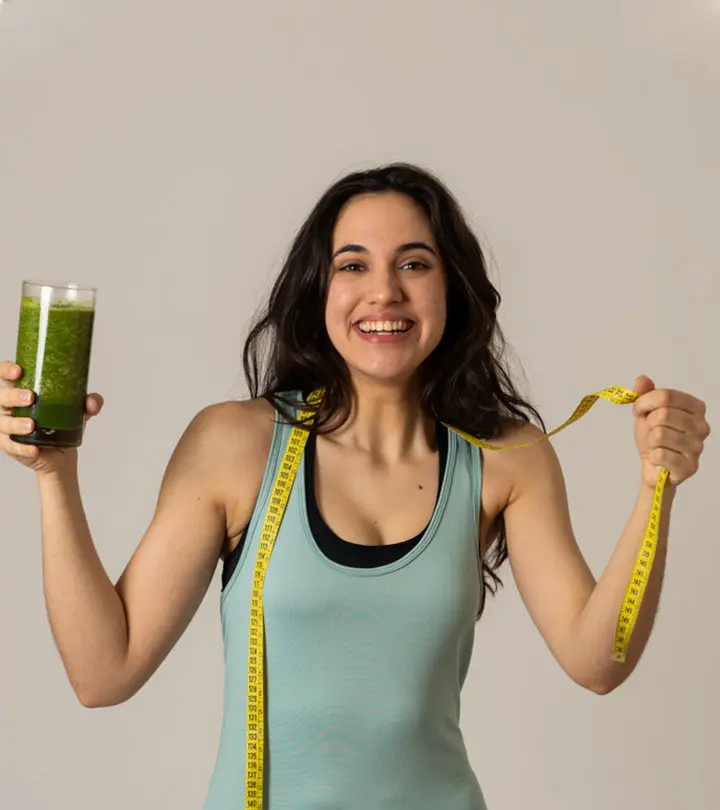


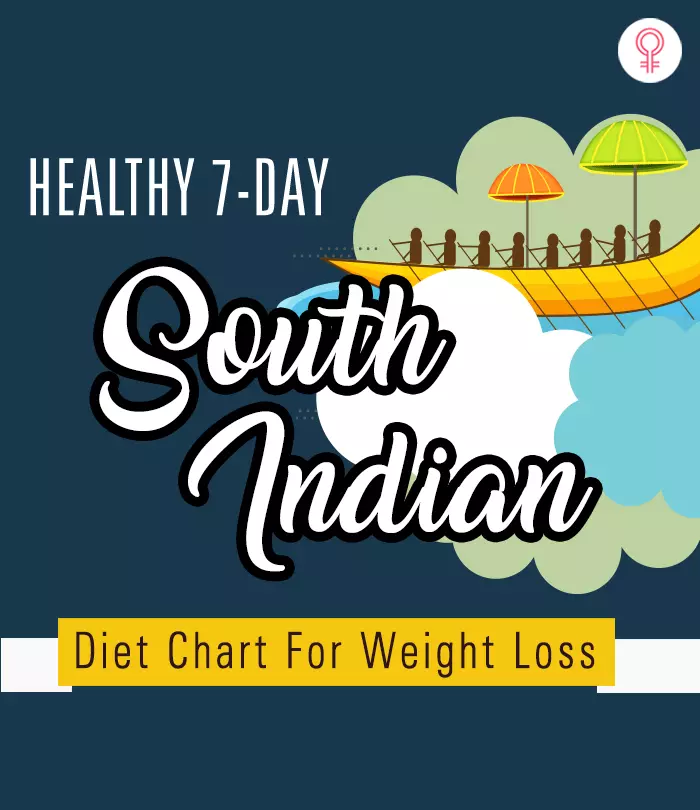
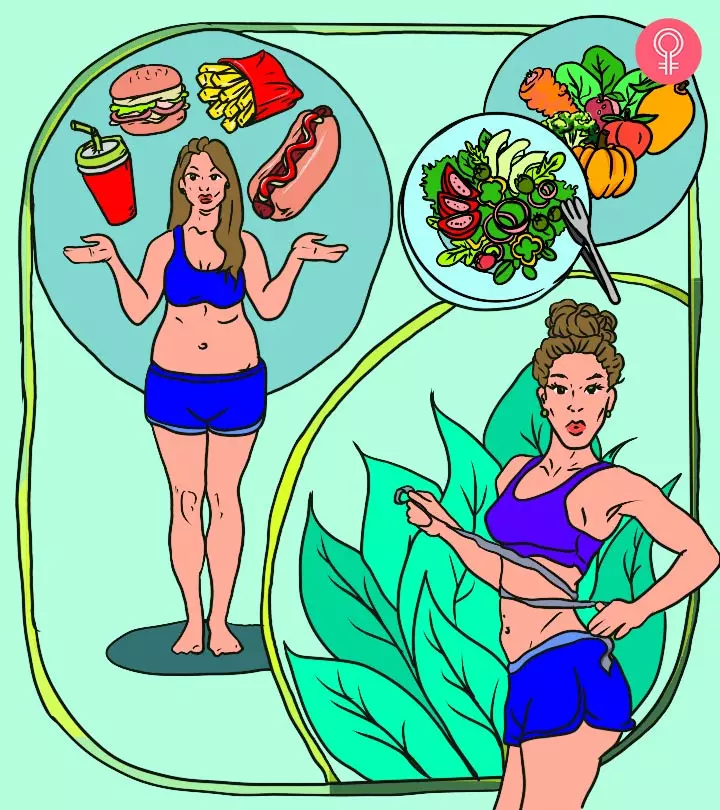



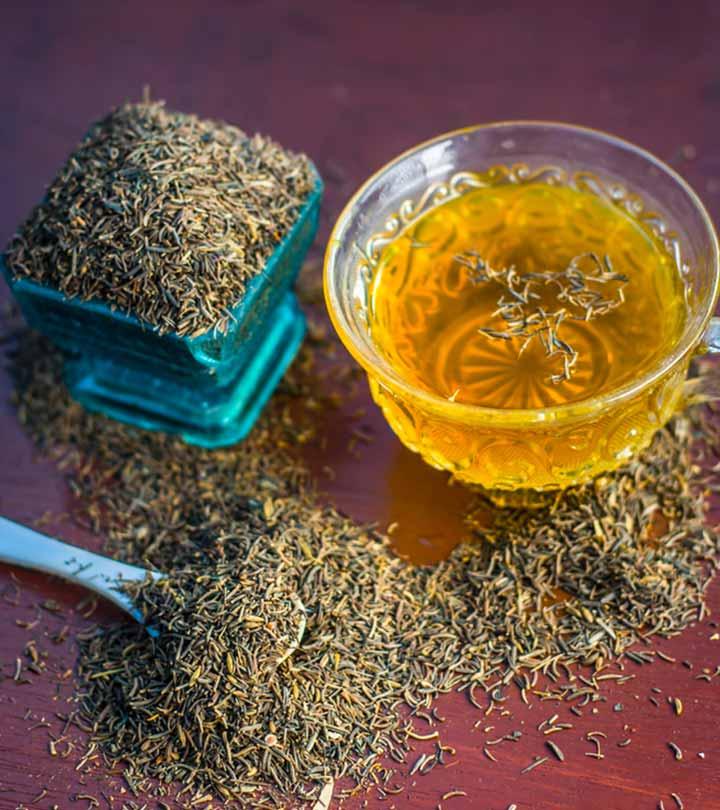


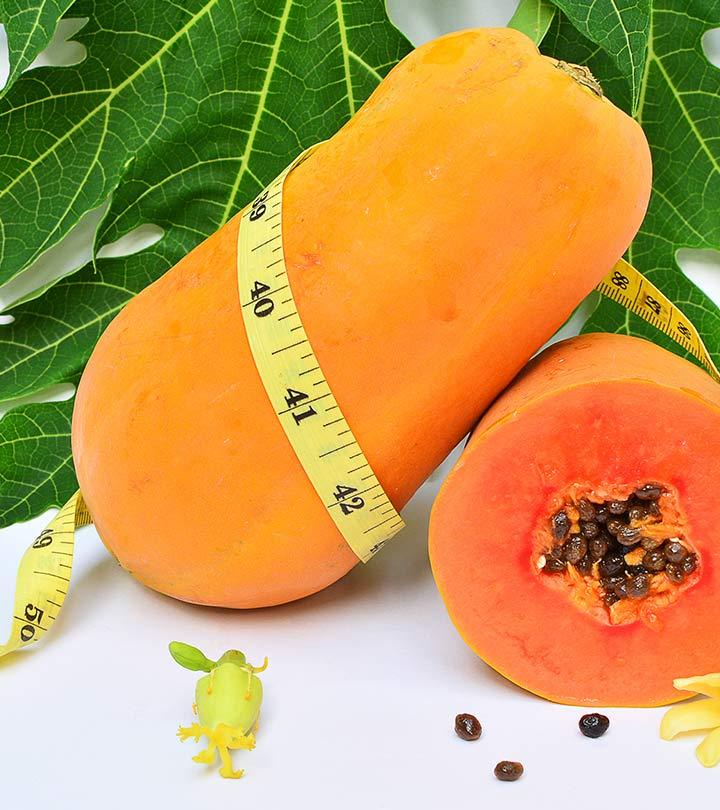
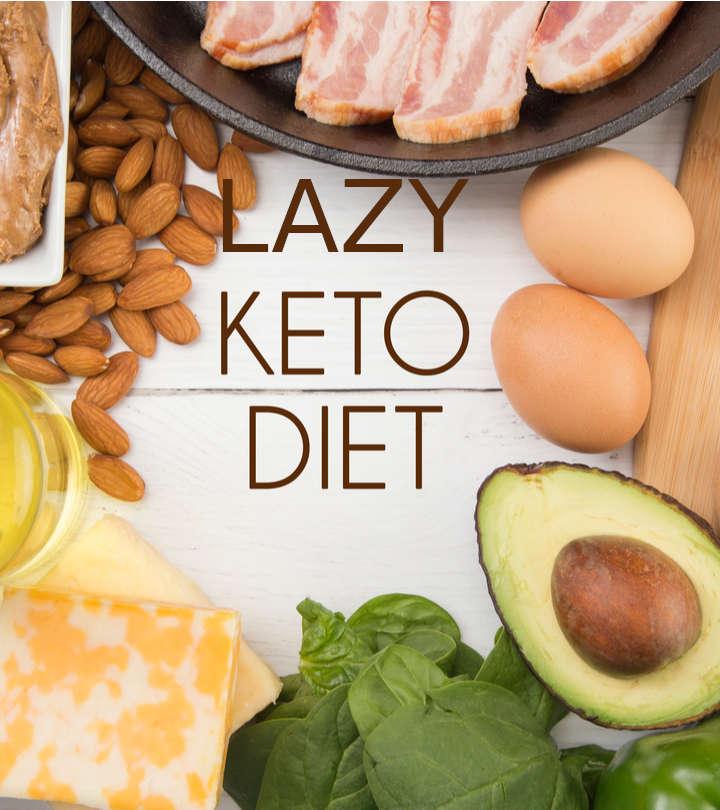




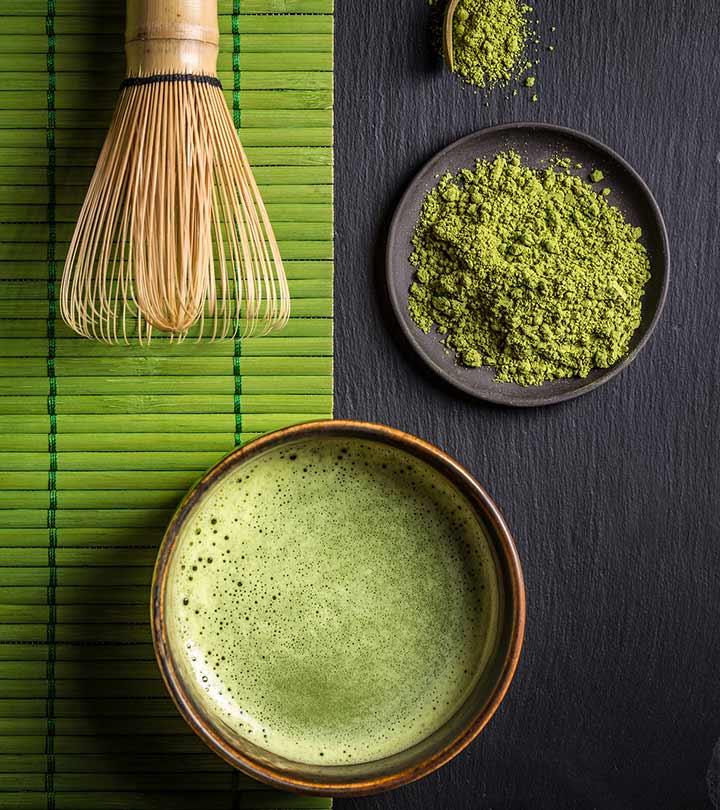


Community Experiences
Join the conversation and become a part of our empowering community! Share your stories, experiences, and insights to connect with other beauty, lifestyle, and health enthusiasts.